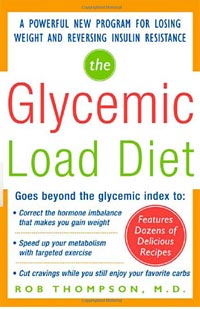Medical Doctor Explains Glycemic Index Glycemic Load
Post by RightEatingHabitscom – Would knowing the Glycemic Index and Glycemic Load of everyday foods help you make smart food choices? Smart food choices that will support your quest for faster weight loss? Further to my earlier post on the Glycemic Load Diet, I came across an article by Dr. Gabe Mirkin which explains clearly the difference between the Glycemic Load and Glycemic Index. Dr. Mirkin has practised medicine for more than 40 years and was a graduate of Harvard University and Baylor University College of Medicine. Read on to find out why knowing the Glycemic Load of foods can help you make smart food choices for faster weight loss.
Glycemic Index, Glycemic Load, Weight Loss Explained
By Gabe Mirkin, M.D.
 “When you eat a food, your blood sugar level rises. The food that raises blood sugar the highest is pure table sugar. Glycemic index is a ratio of how high a particular food raises blood sugar in comparison to how high table sugar raises blood sugar levels.
“When you eat a food, your blood sugar level rises. The food that raises blood sugar the highest is pure table sugar. Glycemic index is a ratio of how high a particular food raises blood sugar in comparison to how high table sugar raises blood sugar levels.
Foods whose carbohydrates break down slowly release glucose into the bloodstream slowly, so blood sugar levels do not rise high and therefore these foods have low glycemic index scores. Those that break down quickly cause a high rise in blood sugar and have a high glycemic index.
Most beans, whole grains and non-starchy vegetables have low glycemic index; while sugars, refined grains made from flour, fruits and root vegetables have a high glycemic index.
If you try to use glycemic index tables to guide your choice of foods, you will see things that should bother an intelligent person. A carrot has almost the same glycemic index as sugar. That is ridiculous. You know that a carrot is a far wiser choice for dieters or diabetics than table sugar.
Glycemic Load Another Way To Measure Foods
To deal with this conflict, researchers developed a new measure to rank foods called Glycemic Load (GL). To calculate glycemic load, the grams of carbohydrate in a serving of food are multiplied by that food’s glycemic index/100.
Carrots and potatoes both have a high glycemic index, but using the GL index, carrots dropped from high GI of 131 to a GL of 10. Potatoes fall from a GI of 121 to a GL of 45. Air-popped popcorn, with a glycemic index of 79, has a GL of 4.
Foods that are mostly water or air will not cause a steep rise in your blood sugar even if their glycemic index is high. That’s why Glycemic Load is more useful. However, all of these tools should be used for research and not for your daily selection of foods. Use your own common sense and eat plenty of fruits, vegetables, whole grains, beans and other seeds. If you are diabetic, you can eat root vegetables and fruits with other foods to slow the rise in blood sugar they may cause.
Recommended reading: Eat, Drink, and Be Healthy: The Harvard Medical School Guide to Healthy Eating (Simon & Schuster, June 2001), by Harvard School of Public Health professor and researcher Walter Willett, M.D.”
Use Both Indexes To Make Smart Food Choices For Faster Weight Loss
To make smart food choices, both indexes are needed as they are inter-related. To calculate the glycemic load of a food, you need its glycemic index. The difference between two is that the glycemic index measures how fast the body digests carbohydrate foods and converts them into glucose, while the glycemic load measures the amount of carbohydrate in a food serving.
For a low glycemic index diet to work, it should incorporate both low GI (these are slow glucose releasing foods) and low glycemic load foods (these are low calorie foods). Examples of both low GI and low glycemic load foods are lentils, green peas, chickpeas, kidney beans, rye bread, and green vegetables.
Get amazing results with these natural weight Loss guides:
These two books explain how the low glycemic load diet works in great detail. There is no need to agonise over the exact glycemic index and glycemic load scores of every meal you take. The books have included several low GL recipes which are easy to prepare so you can start making smart food choices right away!
“Having metabolic syndrome, I bought several books about this and sent everything back accept the Glycemic-Load Diet. Dr. Thompson explains it all clearly and in such an interesting way. I cannot believe how easy it is and how fast it works” – one reader’s comment

